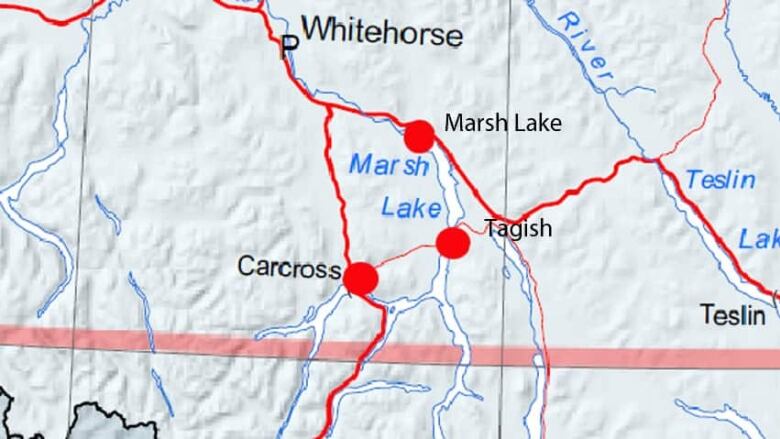Avoid going on Schwatka Lake while water levels drop: Yukon Energy
Yukon Energy says there's a possibility of ice breaks and fast flowing water

Yukoners are being asked to avoid going on the ice on Schwatka Lake starting Wednesday as ice breaks and fast flowing water are possible.
Over the next week, water levels areexpected to fall at Schwatka Lake as Yukon Energy continues to increase the flow of water through Miles Canyon and the Whitehorse dam as part of the effort to lower water levels on Marsh Lake,according to a news release.
The lower water levels on Schwatka Lake could cause breaking ice along the lake's shorelines and the ice conditions might be unpredictable, the release says.
Water flowing under the ice surface may also move faster than usual.
Snowpack 172% above normal
Yukon Energy started increasing flows at the Whitehorse dam earlier in March after the Yukon government's snow survey for the month showed snowpack levels in the Southern Lakes region to be 172 per cent above normal.
Water levels on Marsh Lake were also forecast to potentially peak at almost 657 metres about 52 centimetresbelow water levels reached during the 2007 flood.
Yukon Energy says all 30 gates at the Lewes River Control were opened as of March 19, an initial measure to lower levels on Marsh Lake.
As of 8 a.m. Wednesday, Marsh Lake levels were at about 655 metres above sea level and 60 centimetres lower than lake levels on March 1, 2021.
The energy organization lowers lake levels on Marsh Lake every spring by generating hydroelectricity at the Whitehorse dam to make room for rain and spring melt.
Typically, the water levels reach a low in late May of about 654 metres the lowest level allowed under Yukon Energy's current water use licence.
Doug Phillips knows all about flood potential in Marsh lake, he has lived in the area for close to 25 years. In 2007, he filled thousands of sandbags to try and protect his home from high water.
He says when it comes to lowering the levels on the lake, timing is key. He says he's thankful the gates to the dam are now open something that didn't happen until May in 2007.
"The problem with doing that late is that because the Yukon River at the end of Marsh Lake is like a coke bottle, ... you can't catch up once you're behind,"Phillips said.
"There's so much water coming into it That's what happened in 2007. And we should have learned the lesson from that. And I'm hoping that this year will be better."
Since snowpack levels were especially high this spring, Yukon Energy says it plans to apply for an emergency amendment to its water license to draw the lake levels down 10 centimetres lower than the existing low supply level.
Yukon Energy says an updated peak water level forecast for Marsh Lake will be provided sometime in April.
Corrections
- In an earlier version of this story, Yukon Energy stated that as of Wednesday, Marsh Lake levels were at about 655 metres above sea level and 60 centimetres lower than lake levels on March 1, 2020. The utility later said the correct date for comparison is March 1, 2021.Apr 01, 2021 9:44 AM CT












_(720p).jpg)


 OFFICIAL HD MUSIC VIDEO.jpg)
.jpg)



























































































